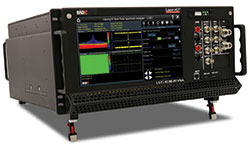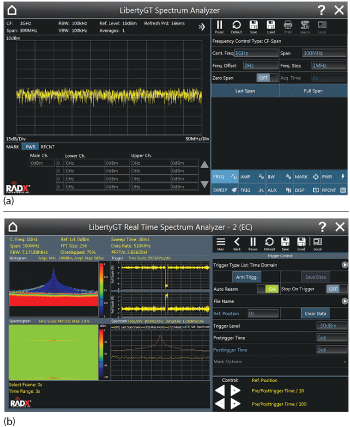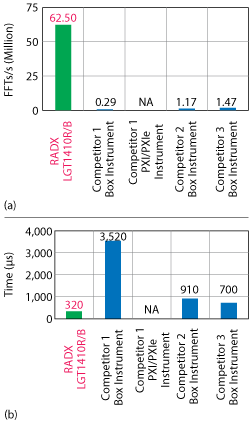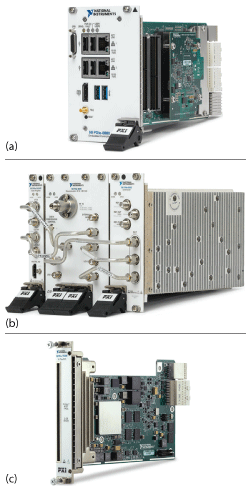
With their ability to detect, analyze and record elusive signals that are effectively invisible to conventional spectrum analyzers, real-time spectrum (or signal) analyzers (RTSA) have become an essential tool for RF, microwave, radar and electronic warfare applications. As more wideband communication systems incorporate spread spectrum and frequency hopping technologies and since intermittent interference can cause critical interruptions of service in these systems, leading RF test and measurement (T&M) companies now offer advanced, integrated, touchscreen, box instrument RTSAs with real-time analysis bandwidths over 500 MHz, long duration spectrum recording (external), flexible triggering modes and the ability to detect signals with 100 percent probability of intercept (POI) with full amplitude accuracy that are substantially under 15 µs in duration (see Figure 1). One hundred percent POI is a critical metric for assessing RTSA performance, since it prescribes the minimum duration of a signal that can be repeatedly and reliably detected, captured and analyzed by an RTSA. These advanced box instrument RTSAs currently range in price from $170,000 to over $300,000, depending on configuration.

Figure 1 A 300 ns pulse eludes detection in a typical spectrum analyzer (a) yet is readily detected by the LGT1410 RTSA (b).
THE FIRST MODULAR RTSA
Historically, modular instruments (e.g., VXI, PXI, PXIe) have primarily been employed by integrators in automated test systems (ATS) and by experimenters willing to develop their own applications using example programs from suppliers. Until recently, performance limitations of commercial RF modules and the lack of modular, integrated, touchscreen-optimized, RF T&M platforms precluded the possibility of a commercial off-the-shelf (COTS) modular, advanced RTSA.
That changed in May 2016, when RADX Technologies Inc. (RADX®) introduced the LibertyGT® 1410 real-time vector signal analyzer (LGT1410-RTVSA), the first advanced, integrated, modular, COTS, software-defined, touchscreen-optimized RTSA. The LGT1410 is based on the National Instruments (NI) PXIe-5668R vector signal analyzer (VSA). The NI VSA features exceptional RF capabilities, a 20 Hz to 26.5 GHz frequency range, 765 MHz real-time analysis bandwidth and support for real-time, peer-to-peer streaming of I/Q samples for RTSA processing. The LGT1410 combines the PXIe-5668R with the RADX LibertyGT FPGA-based, real-time, touchscreen-optimized Measurement Science Firmware and Software (MSFS).This combination creates the first modular RTSA that delivers industry-leading performance, ease-of-use and multiple benefits that accrue from the system’s modular, software-defined, open architecture. Coupled with a starting price under $150,000 for a fully-featured, turnkey system, the LGT1410 is also the first modular, advanced RTSA that effectively competes in price, performance and features with proprietary, box instrument RTSAs.
With its dedicated, real-time, FPGA based MSFS, the LGT1410 can process up to 62.5 million fast Fourier transforms (FFT) per second, which is better than the nearest RTSA competitor by over an order of magnitude. The LGT1410 delivers an industry-leading 320 ns minimum signal duration with 100 percent POI at full amplitude accuracy, which is 2x to 10x shorter than its closest rival (see Figure 2).

Figure 2 Comparison of RTSA performance at 26.5 GHz: FFTs/s (a) and minimum signal duration for 100 percent POI (b).
Unlike proprietary, boxed instrument RTSAs, the LGT1410 is truly modular. The LGT1410 is based on NI PXIe modules: the PXIe-8880 Intel® Xeon® based embedded controller, PXIe-5668R VSA and PXIe-7976R Xilinx® Kintex®-7 FPGA module (see Figure 3). The modules are deployed in either a reference NI PXIe-1085 24 GB/sec chassis (LGT1410R) or a RADX patent-pending, touchscreen-equipped, 24 GB/Sec PXI/PXIe benchtop enclosure (LGT1410B) that features a unique, hinged front panel for easy access to the PXI/PXIe modules mounted inside.
As a PXI/PXIe-based, software-defined instrument, the LGT1410 supports module-level software and hardware technology insertion that enables seamless, cost-effective upgrades and enhancements, module-level spares, repairs and calibration, and the virtual elimination of life-time-buys for end-of-life subsystems—all of which enable the system to provide superior mean-time-to-repair (MTTR) and reduced total cost of ownership (TCO), compared to monolithic box instruments.
The LGT1410’s software-defined architecture enables the system to support multiple LibertyGT applications (apps). The apps are synthesized on the system’s hardware, which eliminates the need for additional instruments and reduces system size, weight and power, along with acquisition and operating costs.
CAPABILITIES AND OPTIONS
The LGT1410 includes the LibertyGT object-oriented, LabVIEW-based MSFS framework with touchscreen GUI, VISA TCP/IP remote interface, comprehensive applications programming interface (API) and the following standard apps:
- Real-time spectrum analyzer (RTSA-2) with 320 ns minimum signal duration at 100 percent POI with full amplitude accuracy (export license required)
- Spectrum analyzer
- Real-time vector signal analyzer (RTVSA) with standard digital and analog demodulators
- SSD-based narrowband signal and spectrum recording and playback
- Standard DSP-based RF power, RF counter and error meters
- Internal bit error rate (BER) tester, pattern generator and receiver (via RF, Ethernet, RS-232C or USB)
- Internal audio analyzer (via RF and Ethernet)

Figure 3 Modular components of the LGT1410: PXIe-8880 embedded controller (a) PXIe-5668R VSA (b) and PXIe-7976R FPGA module (c).
Because of its modular, software-defined architecture, the LGT1410 supports extensive internal options that enable the LGT1410 to be upgraded to provide a complete benchtop ATS capability. The LGT1410, unlike boxed instruments, does not require additional external subsystems to upgrade, although some may require additional PXI/PXIe modules (noted by *):
- Multi-channel real-time VSA for simultaneous capture, demodulation and analysis of up to 128 channels
- Internal LabVIEW or MATLAB post processing
- Dozens of NI and third party apps available via the LabVIEW Tools Network (see www.ni.com/labview-tools-network)
- Advanced spectrum recording with 8 to 64 TB of internal RAID modules* that supports up to 765 MHz bandwidth
- Internal IRIG-B or GPS time-stamping* for spectrum monitoring
Second RTSA channel* - 10 Gigabit Ethernet*
- Internal RF or vector signal generator*
- Internal digital storage oscilloscope (DSO)*
- Internal digital multi-meter (DMM)*
All LGT1410 apps are accessible via the system’s intuitive HD 1080 pixel touchscreens, standard VISA/TCP/IP remote interface and the included LibertyGT API, which supports programming in LabVIEW, TestStand, Python, C, C++ and Java. The LGT1410 also includes a powerful, Intel Xeon-based embedded controller that eliminates the need for a separate test executive computer for sequencing automated tests. Since all the LGT1410 apps are part of a unified programming environment, test programming on the LGT1410 is greatly simplified.
A fully configured, integrated LGT1410R including RTSA-2 (export license required) starts at $148,500 and is available with an 8 to 12-week lead-time from RADX. LGT1410 kits, including RADX MSFS, accessories and RADX touchscreen PXIe enclosures are available for customers with existing NI purchasing relationships.
RADX Technologies Inc.
San Diego, Calif.
www.radxtech.com
